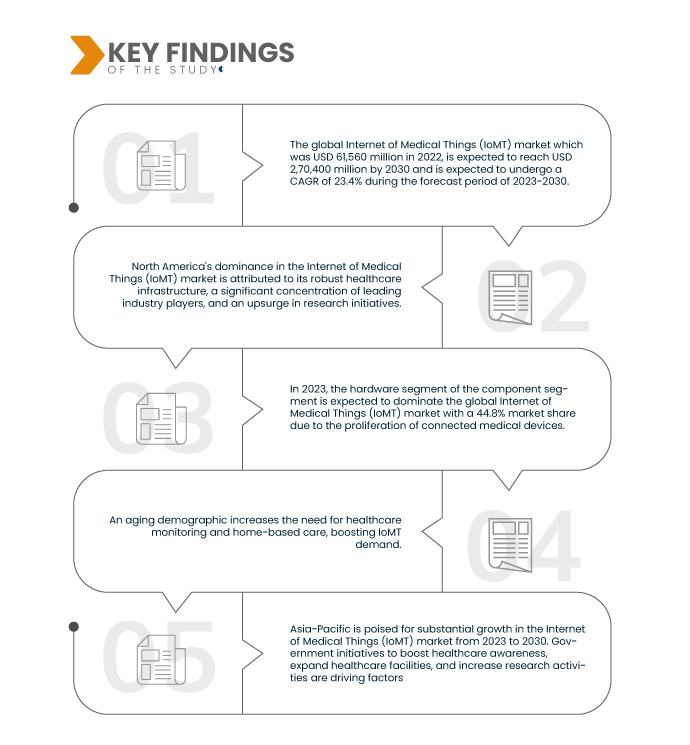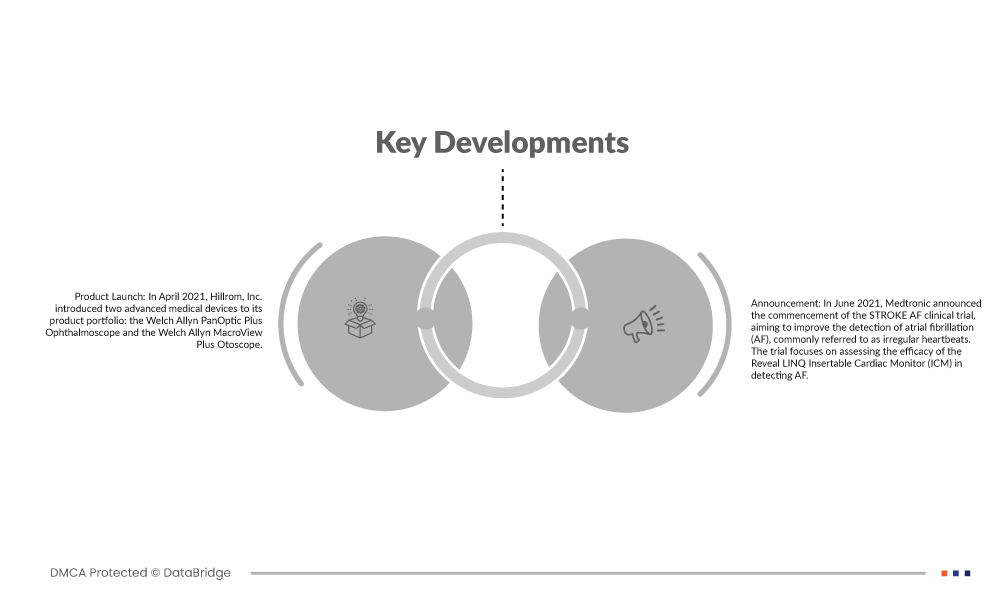The Internet of Medical Things (IoMT) is driving transformative innovations in healthcare. Connected devices collect real-time patient data, enhancing remote monitoring, diagnostics, and treatment. The dominating segment is remote patient monitoring, allowing healthcare providers to track patients' vital signs, chronic conditions, and medication adherence remotely. IoMT also includes smart implants, wearable health tech, and telehealth solutions, revolutionizing patient care and healthcare delivery. These innovations improve patient outcomes, reduce hospitalization rates, and contribute to more efficient, patient-centric healthcare systems.
Access Full Report @ https://www.databridgemarketresearch.com/reports/global-internet-of-medical-things-iomt-market
Data Bridge Market Research analyses that the Global Internet of Medical Things (IoMT) Market which was USD 61,560 million in 2022, is expected to reach USD 2,70,400 million by 2030, and is expected to undergo a CAGR of 23.4% during the forecast period of 2023-2030. Increasing health consciousness among consumers is driving demand for wearable health technology and Internet of Medical Things (IoMT) solutions. These technologies empower individuals to actively monitor their health, promoting early detection and prevention, and aligning with the trend toward proactive healthcare management.
Key Findings of the Study
Government initiatives are expected to drive the market's growth rate
Supportive policies and incentives play a pivotal role in promoting the implementation of Internet of Medical Things (IoMT) solutions. Governments and regulatory bodies worldwide are recognizing the potential of IoMT in enhancing healthcare delivery, reducing costs, and improving patient outcomes. By offering financial incentives, regulatory frameworks, and data protection guidelines, these policies foster a conducive environment for healthcare providers and tech companies to invest in and adopt IoMT technologies, ultimately benefiting both healthcare systems and patients.
Report Scope and Market Segmentation
|
Report Metric
|
Details
|
|
Forecast Period
|
2023 to 2030
|
|
Base Year
|
2022
|
|
Historic Years
|
2021 (Customizable to 2015-2020)
|
|
Quantitative Units
|
Revenue in USD Million, Volumes in Units, Pricing in USD
|
|
Segments Covered
|
Component (Hardware, Software, and Services), Platform (Device Management, Application Management, Cloud Management), Mode of Service Delivery (On-Premise, Cloud), Connectivity Devices (Wired, Wireless), Application (On-Body Devices, Healthcare Providers, Home-Use Medical Devices, Community, Others), End-User (Hospitals, Clinics, Research Institutes and Academics, Homecare, Others)
|
|
Countries Covered
|
U.S., Canada, and Mexico in North America, Germany, France, U.K., Netherlands, Switzerland, Belgium, Russia, Italy, Spain, Turkey, Rest of Europe in Europe, China, Japan, India, South Korea, Singapore, Malaysia, Australia, Thailand, Indonesia, Philippines, Rest of Asia-Pacific (APAC) in the Asia-Pacific (APAC), Saudi Arabia, U.A.E, South Africa, Egypt, Israel, Rest of Middle East and Africa (MEA) as a part of Middle East and Africa (MEA), Brazil, Argentina and Rest of South America as part of South America.
|
|
Market Players Covered
|
Siemens Healthcare (Germany), General Electric (U.S.), Biotronik SE & Co. KG (Germany), Medtronic (Ireland), Boston Scientific Corporation (U.S.), Hill-Rom Services, Inc. (U.S.), Neurometrix, Inc. (U.S.), Honeywell International Inc. (U.S.), VitaConnect (U.S.), EKso Bionics (U.S.), BL Healthcare, Inc. (U.S.), BioSerenity, Koninklijke Philips N.V. (Netherlands), Lenovo (China), AliveCor, Inc. (U.S.)
|
|
Data Points Covered in the Report
|
In addition to the insights on market scenarios such as market value, growth rate, segmentation, geographical coverage, and major players, the market reports curated by the Data Bridge Market Research also include depth expert analysis, patient epidemiology, pipeline analysis, pricing analysis, and regulatory framework.
|
Segment Analysis:
The global Internet of Medical Things (IoMT) market is segmented on the basis of component, platform, mode of service delivery, connectivity devices, application, and end-user.
- On the basis of component, the global Internet of Medical Things (IoMT) market is segmented into hardware, software, and services. In 2023, the hardware segment is expected to dominate the global Internet of Medical Things (IoMT) market with a 44.8% market share due to the proliferation of connected medical devices.
In 2023, the hardware segment of the component segment is anticipated to dominate the global Internet of Medical Things (IoMT) market
In 2023, the hardware segment is expected to dominate the global Internet of Medical Things (IoMT) market with a 44.8% market share due to the proliferation of connected medical devices. These hardware components, such as sensors, wearables, and medical monitoring devices, form the foundation of IoMT ecosystems, facilitating data collection and transmission, which is essential for remote patient monitoring, diagnostics, and healthcare system integration.
- On the basis of platform, the global Internet of Medical Things (IoMT) market is segmented into device management, application management, and cloud management. In 2023, the device management segment is positioned to dominate the global Internet of Medical Things (IoMT) market with a 35.20% market share as it plays a critical role in efficiently managing and maintaining a vast network of connected medical devices.
In 2023, the device management segment of the platform segment is anticipated to dominate the global Internet of Medical Things (IoMT) market
In 2023, the device management segment is positioned to dominate the global Internet of Medical Things (IoMT) market with 35.20% market share as it plays a critical role in efficiently managing and maintaining a vast network of connected medical devices. It ensures seamless data transmission, device security, and software updates, which are essential for the effective functioning and integrity of IoMT systems, making it a pivotal segment of the ecosystem.
- On the basis of mode of service delivery, the global Internet of Medical Things (IoMT) market is segmented into on-premise, and cloud. In 2023, the on-premise segment is set to dominate the global Internet of Medical Things (IoMT) market with a 59.82% market share as healthcare providers prioritize data control and security. On-premise solutions offer direct control over IoMT infrastructure, ensuring compliance with regulatory standards and safeguarding sensitive medical data, making them the preferred choice in healthcare settings.
- On the basis of connectivity devices, the global Internet of Medical Things (IoMT) market is segmented into wired, and wireless. In 2023, the wired segment is projected to lead the global Internet of Medical Things (IoMT) market with a 64.97% market share due to its reliability and data security. Wired connections offer consistent, high-speed data transmission crucial for medical applications, ensuring the integrity and privacy of patient data in healthcare environments.
- On the basis of application, the global Internet of Medical Things (IoMT) market is segmented into on-body devices, healthcare providers, home-use medical devices, community, and others. In 2023, the on-body devices segment is poised to dominate the global Internet of Medical Things (IoMT) market with a 33.28% market share as it includes wearable medical devices. These devices enable continuous monitoring and real-time data collection, playing a pivotal role in remote patient care, disease management, and wellness tracking, making them a significant IoMT category.
- On the basis of end-user, the global Internet of Medical Things (IoMT) market is segmented into hospitals, clinics, research institutes and academics, homes, and others. In 2023, the hospitals segment is anticipated to lead the global Internet of Medical Things (IoMT) market with a 52.93% market share due to its extensive adoption of connected medical devices and data-driven healthcare solutions. Hospitals rely on IoMT for remote patient monitoring, asset tracking, and enhanced patient care, making it a central segment in the IoMT ecosystem.
Major Players
Data Bridge Market Research recognizes the following companies as the global Internet of Medical Things (IoMT) market players in global Internet of Medical Things (IoMT) market Siemens Healthcare (Germany), General Electric (U.S.), Biotronik SE & Co. KG (Germany), Medtronic (Ireland), Boston Scientific Corporation (U.S.), Hill-Rom Services, Inc. (U.S.), Neurometrix, Inc. (U.S.), Honeywell International Inc. (U.S.), VitaConnect (U.S.).
Market Developments
- In April 2021, Hillrom, Inc. introduced two advanced medical devices to its product portfolio: the Welch Allyn PanOptic Plus Ophthalmoscope and the Welch Allyn MacroView Plus Otoscope. These cutting-edge instruments are designed to enhance clinical examinations in ophthalmology and otolaryngology, respectively. The PanOptic Plus offers improved views of the eye's fundus, while the MacroView Plus provides superior visualization of the ear canal and eardrum, facilitating more accurate diagnoses and treatments for patients.
- In June 2021, Medtronic announced the commencement of the STROKE AF clinical trial, aiming to improve the detection of atrial fibrillation (AF), commonly referred to as irregular heartbeats. The trial focuses on assessing the efficacy of the Reveal LINQ Insertable Cardiac Monitor (ICM) in detecting AF. This innovative cardiac monitor provides continuous heart rhythm monitoring, enabling better identification of AF, which is crucial for early intervention and preventing stroke and other associated complications.
Regional Analysis
Geographically, the countries covered in the global Internet of Medical Things (IoMT) market report are U.S., Canada and Mexico in North America, Germany, France, U.K., Netherlands, Switzerland, Belgium, Russia, Italy, Spain, Turkey, Rest of Europe in Europe, China, Japan, India, South Korea, Singapore, Malaysia, Australia, Thailand, Indonesia, Philippines, Rest of Asia-Pacific (APAC) in the Asia-Pacific (APAC), Saudi Arabia, U.A.E, South Africa, Egypt, Israel, Rest of Middle East and Africa (MEA) as a part of Middle East and Africa (MEA), Brazil, Argentina and Rest of South America as part of South America.
As per Data Bridge Market Research analysis:
North America is the dominant region in the global Internet of Medical Things (IoMT) market during the forecast period 2023 - 2030
North America's dominance in the Internet of Medical Things (IoMT) market is attributed to its robust healthcare infrastructure, a significant concentration of leading industry players, and an upsurge in research initiatives. With a well-established foundation for healthcare technology adoption, the region is at the forefront of leveraging IoMT to enhance patient care, drive medical advancements, and improve healthcare system efficiency, consolidating its leadership position in the global IoMT market.
Asia-Pacific is expected to dominate the global Internet of Medical Things (IoMT) market in the forecast period 2023 - 2030
Asia-Pacific is poised for substantial growth in the Internet of Medical Things (IoMT) market from 2023 to 2030. Government initiatives to boost healthcare awareness, expand healthcare facilities, and increase research activities are driving factors. Additionally, the region's vast untapped markets, a significant population base, and rising demand for quality healthcare contribute to its IoMT market potential. These factors position Asia-Pacific as a key player in the global IoMT landscape.
For more detailed information about the global Internet of Medical Things (IoMT) market report, click here – https://www.databridgemarketresearch.com/reports/global-internet-of-medical-things-iomt-market












